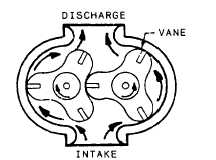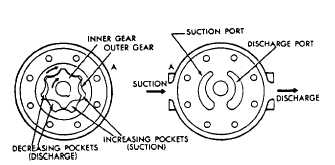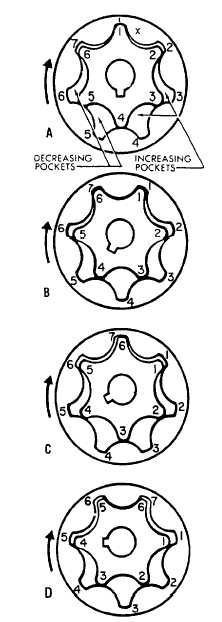
Figure 10-4.-Lobe type of pump.
The inlet port is connected to the fluid supply line, and the outlet port is connected to the pressure line. Referring to the figure, the drive gear is rotating in a counterclockwise direction, and the driven gear (idler gear) is rotating in a clockwise direction. As the teeth pass the inlet port, fluid is trapped between the teeth and the housing; this liquid is carried around the housing to the outlet port. As the teeth mesh again, the liquid between the teeth is displaced into the outlet port. This action produces a positive flow of liquid into the system. A shear pin or shear section is incorporated in the drive shaft to protect the power source or reduction gears if the pump fails because of excessive load or binding of parts.
A variation of the spur tooth pump is the lobe pump (fig. 10-4), which is also used on many diesel-powered equipments for an intake blower as well as in a variety of hydraulic systems. The principle of operation of this pump is exactly the same as the spur tooth. The lobes are so constructed that there is a continuous seal (vane) at the point of juncture at the center of the pump and also on the housing.
Another popular style of gear pump is the internal gear (fig. 10-5). This pump consists of a pair of gear-shaped elements (one within the other) located in

Figure 10-5.-Internal gear type of pump.

Figure 10-6.-Principles of operation of the internal gear type of pump.
the pump chamber. The inner gear is connected to the drive shaft of the source of power.
For an explanation of the operation of this type of pump, refer to figure 10-6. The teeth of the inner gear and the spaces between the teeth of the outer gear are numbered. Note that the inner gear has one less tooth than the outer gear has spaces. The tooth force of each gear is related to that of the other in such away that each tooth of the inner gear is always in sliding contact with the surface of the outer gear. Each tooth of the inner gear meshes with the outer gear at just one point during each revolution. In the illustration, this point is at the top (X). In view A, tooth 1 of the inner gear is in mesh with
Continue Reading